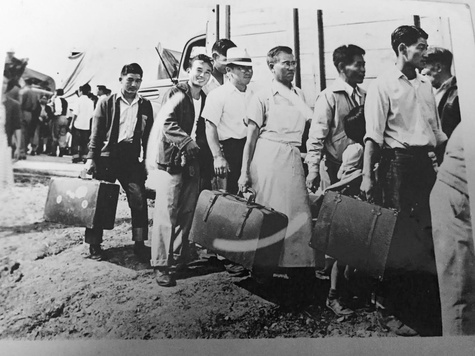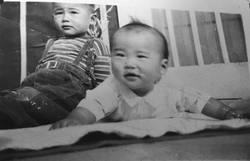If you ever wanted to get a sense of what life actually felt like in camp, look no further than this contraband film from the Nobori family, shot inside Jerome, Arkansas. This 8 mm “day in the life” was filmed by the father, George and leaves a time capsule so perfectly preserved for those of us who want to go beyond still pictures. The family’s candid footage reveals lightheartedness in a sober situation. It shows people making the best of their days amid dust, mess halls and rattlesnakes. Watch the film below:
George Nobori Sr. also took brilliant candid photos inside Jerome, all of which are in the article below. I spoke with Larry Nobori, the baby in the stroller. Now 74 and living in Oregon, Larry is a versatile jazz musician who leads the Minidoka Swing Band. The band’s music pays homage to the sounds of internment: 1940s, big band era songs that were played at many Saturday night dances in camp, integral to keeping spirits up. Once a music teacher in Portland Public Schools, he retired in 2001. He was gracious enough to speak to me over the phone from his home in Portland.
* * * * *
The footage that we have is actually illegal.
I was thinking it might be because even normal photography wasn’t allowed. Do you know how he was able to sneak it in?
I don’t know. I don’t know what the circumstances were. I know that he showed it when we were kids. Don is our youngest brother and he’s the one that put it [the film] together. But we never did legalize the copyright, anybody can use it.
It’s such a great video. The fact that it’s really long is fascinating because he took so much footage. Were you born after the camps?
I was just born, George [brother] is a couple of years older than me. And so I was born in Sacramento because my family left the Bay Area to go to Florin because my dad thought that we wouldn’t be interned. So my mom was pregnant, we went up to Sacramento and then I was born. They were interned anyway.
I guess Sacramento wasn’t far enough to avoid the camp. Were you only in Jerome or in others as well?Well, we weren’t there that long. 6-8 months or something like that. George has a better recollection. It wasn’t that long but we were a young family. My dad wasn’t recruited in the 442nd so we as a young family were chosen to leave early. And so that gave us an opportunity to get out of there. And then he started a new job with the family in Cleveland. Some people got out earlier depending on their situations depending on their ability to get work or stability. I think it’s individually different from family to family. There wasn’t a timeline where they were all released at once.
Did your father ever speak about his experience?
He didn’t talk about it, we didn’t ask too many questions. We were, to my knowledge, a kind of news item in the news reels that used to be in theaters in-between shows. And so my dentist from when we lived in the Bay Area, Dr. Fuji, said, “I want you to see these films I have on internment.” And he’s showing us these films and it’s our family going to Cleveland, released from camp going out into the private sector. And so my dad got a job. I think he worked in a government job in the beginning and then he started to work in the auto business. I don’t know too many specifics but that’s how we ended up in Cleveland.
Have you shown that video to the museums or archival places have it?
My brother Don had my dad’s camera and film. And after my dad had passed, Don brought it to Costco to have it put on a DVD. It was part of a collection of film footage of our family before, during, and after internment. My brother, George Nobori Jr., help start the SF Bay Area J-Town Jazz Band, with noted author/musician George Yoshida, who wrote the book Reminiscing In Swingtime.
I similarly was asked to direct a youth group called the Minidoka Swing Band to present the music and dance of the internment era. In October 2007, we made a pilgrimage to Minidoka. Wall Street Journal reporter Joel Millman took an interest in the band and wrote a front page article in the WSJ.
*This article was originally published on Tessaku on December 20, 2016.
© 2017 Emiko Tsuchida









